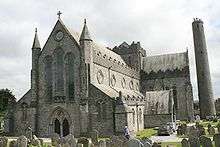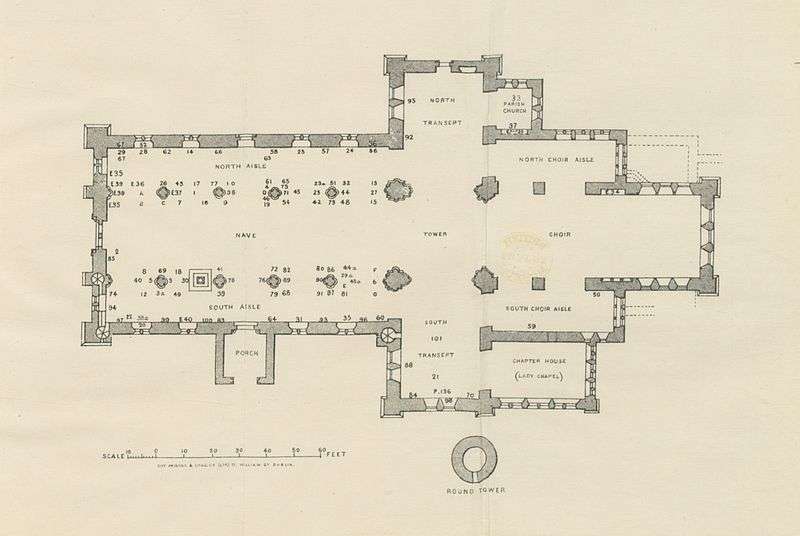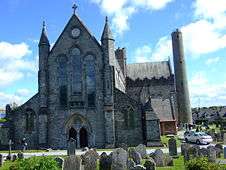St Canice's Cathedral
| St Canice's Cathedral | |
|---|---|
 | |
| 52°39′24.40″N 07°15′25.72″W / 52.6567778°N 7.2571444°WCoordinates: 52°39′24.40″N 07°15′25.72″W / 52.6567778°N 7.2571444°W | |
| Location | County Kilkenny |
| Country | Ireland |
| Denomination | Church of Ireland |
| Website | www.stcanicescathedral.com |
| History | |
| Dedication | St. Canice |
| Architecture | |
| Style | Gothic |
| Administration | |
| Diocese | Diocese of Cashel and Ossory |
| Province | Province of Dublin |
| Clergy | |
| Bishop(s) | The Right Reverend Michael Burrows |
| Dean | The Very Reverend Katherine Poulton |
| Precentor | The Reverend MA McCullagh |
| Curate(s) | The Reverend David Compton |
| Archdeacon | The Venerable JG Murray |
| Laity | |
| Organist/Director of music | Mr Malcolm Proud BMus LRAM |
| Organist(s) | Mr D Forde |
St Canice's Cathedral, also known as Kilkenny Cathedral, is a cathedral of the Church of Ireland in Kilkenny city, Ireland. It is in the ecclesiastical province of Dublin.
Previously the cathedral of the Diocese of Ossory, it is now one of six cathedrals in the United Dioceses of Cashel and Ossory.
History
The present building dates from the 13th century and is the second longest cathedral in Ireland, after St. Patrick's Cathedral, Dublin. Beside the cathedral stands a 100 ft 9th-century round tower. St Canice's tower is an example of a well-preserved 9th-century "Celtic Christian" round tower. It is dedicated to St Canice. It is one of only two such medieval round towers in Ireland that can be climbed to the top.[1]
The cathedral stands on an ancient site which has been used for Christian worship since the 6th century. In the 1120s the see of Ossory was moved from Aghaboe to Kilkenny.
Following the English Reformation, the reformed church in Ireland was established by decree of the Irish Parliament to become the state church in the Kingdom of Ireland as the Church of Ireland, taking possession of most church property (and so retaining a great repository of religious architecture and other items, though some were later destroyed). The substantial majority of the population, however, remained faithful to Roman Catholicism, despite the political and economic advantages of membership in the state church. Since St Canice's Cathedral was taken over in this way, Roman Catholic adherents were consequently obliged to worship elsewhere. St Mary's Cathedral in Kilkenny was later built for the Roman Catholic diocese.
The cathedral contains some 16th-century monuments. The architectural style of the cathedral is Early Gothic and is built of limestone. It is richly endowed with many stained glass windows, including the East window which is a replica of the original 13th-century window. The cathedral contains some of the finest 16th-century monuments in Ireland.
Ancient history
Kilkenny was the ancient capital of the Kingdom of Ossory and St Canice's Cathedral stands on a site which has experienced Christian worship since the 6th century. The name of "Kilkenny" itself retains the anglicised version of the Irish Cill Chainnigh, which translates as "Church of Cainneach", or "Canice".
The earliest church on the site is presumed to have been made of wood, later to be replaced in the later medieval period by a romanesque-style stone church. This was in turn replaced by the current imposing medieval cathedral. A few yards from the present south transept stands an imposing 9th-century round tower, 100 ft high.[2] Accessible only by a steep set of internal ladders, it may once have been both a watchtower and a refuge. The summit gives a clear view of Kilkenny and the countryside around. The hill on which the cathedral stands is believed to be the centre of the first major settlement at Kilkenny, and the round tower suggests an early ecclesiastical foundation.[3] Much less is known about the early secular structures, but the area around the cathedral, called Irishtown, is the oldest part of the present city.

There is no mention of Kilkenny in the lives of Cainnech of Aghaboe, Ciarán of Saighir or any of the early annels of Ireland suggesting that in those times it was not of great importance.[4] The Annals of the Four Masters recorded entries for Cill Chainnigh in 1085 ("Ceall-Cainnigh was for the most part burned") and again in 1114 ("... Cill-Cainnigh ... were all burned this year").[4][5]
The present building was begun in the 13th century, when it was at the western end of Kilkenny,[2] and shows some similarities to St Patrick's Cathedral, Dublin, both dating from the same period and completed by the end of the 13th century.[6]
In the Red Book of Ossory, fifteen pages dating from about 1324 contain sixty Latin verses, or Cantilenae, written by Richard Ledred, Bishop of Ossory, better known for his connection with trials for heresy and witchcraft. As stated elsewhere in the Red Book, Ledred wrote these verses "for the Vicars Choral of Kilkenny Cathedral, his priests and clerics, to be sung on great festivals and other occasions, that their throats and mouths, sanctified to God, might not be polluted with theatrical, indecent, and secular songs."[7]
The cathedral was "restored" between 1844 and 1867 without the removal of any important medieval features.[8]
Description

Cruciform, the cathedral was built in the Early English, or English Gothic, style of architecture, of limestone, with a low central tower supported on black marble columns. The exterior walls, apart from the gables, are embattled, and there are two small spires at the west end. The cathedral is seventy-five yards long, and its width along the transepts is forty-one yards.[2]
Inside, high pointed arches form entrances from the nave into the choir and the two transepts. Between the nave and each aisle is a row of five black marble clustered columns, with high moulded arches. The nave is lighted by a large west window and five clerestory windows, while the aisles each have four windows. The choir has a groined ceiling with fine tracery and a central group of cherubs.[2] The baptismal font is medieval and the ancient stone of enthronement for bishops still exists under the seat of the medieval throne in the North Transept, where to this day the bishops of Ossory are enthroned.
The cathedral contains some of the finest ancient monuments in Ireland, including one to Bishop David, and the tombs of many bishops of Ossory and several owners of Kilkenny Castle.[2] The subjects of the memorials stretch widely across the social spectrum, from the great figures of the house of Ormonde to the humble shoemaker and carpenter. In the north transept is the ancient Chair of St Kieran, made of carved stone,[2] still used as the chair of enthronement for the bishops of Cashel and Ossory.
There are continental carvings on the choir stalls and the hammerbeam roof. The cathedral has many stained glass windows, including the fine East window, which is a replica of the 13th-century original.
On the eastern side of the south transept is the consistory court, built by Bishop Pococke, with the chapter house to the north of it. From the north transept a dark passage leads into St Mary's chapel, where the services of St Canice's parish once took place, and a later parish church next to it holds the tomb of Bishop Gafney (died 1576).[2] Despite some 19th-century restoration, the cathedral has been carefully preserved in its original style and form.
Near the cathedral's east end is Bishop's Palace.[2]

St. Canice's Library
Was established in 1693 by Bishop Thomas Otway, it contains many theological documents and artifacts particularly relating to Bishop Otway and Bishop Edward Maurice from the 17th and 18th centuries. In 2013 the Maurice Otway collection was loaned to Maynooth College for restoration and safe keeping; earlier some documents has been moved to Church of Ireland Representative Body house in Dublin.[9]
Burials and memorials
- William de Karlell (died 1383), Chief Baron of the Irish Exchequer, and his brother John (died 1393), Chancellor of St Patrick's Cathedral, Dublin
- James Butler, 2nd Earl of Ormond (1331–1382)
- Piers Butler, 8th Earl of Ormond(c.1467–1539)
- Thomas Butler, 10th Earl of Ormond (1531–1614)
- Walter Butler, 11th Earl of Ormond (1559–1632/3)
- David Rothe (1573–1650), Roman Catholic Bishop of Ossory – a cenotaph to his memory, though his remains were interred in St. Mary's Church
- Griffith Williams (1589?–1672), Bishop of Ossory
- Hugh Hamilton (1729–1805), Bishop of Ossory
See also
References

- ↑ According to St. Canice's Cathedral tour pamphlets, published by the church.
- 1 2 3 4 5 6 7 8 Cathedral of St Canice, extract from A Topographical Dictionary of Ireland (1837)
- ↑ Graves 1857, p. 25
- 1 2 Graves 1857, p. 23
- ↑ Masters, ed., Annals of the Four Masters vol. ii, p. 923, from Irish
- ↑ Day, J. G. F., The Cathedrals of the Church of Ireland (Read Books, 2007, ISBN 1-4067-5730-6) p. 15
- ↑ Grattan Flood, W. H., A History of Irish Music (Dublin: 1906), pp. 89–90 (extract)
- ↑ Lynas, Norman (1997). Kirwan, John, ed. "The restoration of St Canice's Cathedral 1844–1867 under Dean Vignoles". Kilkenny: studies in honour of Margaret M. Phelan: 183–191.
- ↑ Historic Cathedral Books to be moved to Maynooth News - www.kilkennypeople.ie
Further reading
- Author unknown, ed. Masters (1085), "Part 19", Annals of the Four Masters
- Chadwyck-Healey, Inc (1856), Notes and Queries, University of Michigan: Oxford University Press
- Graves, Rev. James (1857), The History, Architecture, and Antiquities of the Cathedral Church of St. Canice, Kilkenny, Grafton Street, Dublin.: Hodges, Smith, & co., p. 22
- Prim's History and Antiquities of Kilkenny Cathedral (1857)
- Hogan, John (1884). Kilkenny: the Ancient City of Ossory, the Seat of its Kings, the See of its Bishops and the Site of its Cathedral. P. M. Egan.
- Clarendon, De Ossoriensi Dioescesi, Clarendon Collection (tom. li. audit. number 4796); Trinity College, Dublin (E. 4.18)., pp. 19–30
- Ledwich, Edward (1804), Antiquities of Ireland, Banton Press, ISBN 9781856520256
- Rae, E. C., 'An O'Tunney masterpiece reconstituted' [16th-century cenotaph in St Canice's cathedral] in Old Kilkenny Review: Journal of the Kilkenny Archaeological Society, 18 (1966), 62–71
- Woodworth, David, 'St Canice's library' in Old Kilkenny Review: Journal of the Kilkenny Archaeological Society, 22 (1970), 5–10; 23 (1971), 15–22
- McCarthy, Michael, 'Eighteenth century cathedral restoration' [Correspondence relating to St Canice's Cathedral, Kilkenny] in Studies; an Irish quarterly review, 65 (1976), 330–343; 66 (1977), 60–76
- Crotty, G. 'The Foulkes monument in St Canice's cathedral' in Old Kilkenny Review: Journal of the Kilkenny Archaeological Society, ns, 2 (1982), 347–351
- Phelan, Margaret M 'Butler tombs and furnishings in St Canice's Cathedral, Kilkenny' in Journal of the Butler Society, 2 (1982), 164–166
- Lightbown, Ronald, 'Impressions of nineteenth-century Kilkenny (1800–50)' in Old Kilkenny Review: Journal of the Kilkenny Archaeological Society, 48 (1996), 57–80
- Phelan, Margaret M, 'An unidentified tomb in St Canice's Cathedral, Kilkenny', in Old Kilkenny Review: Journal of the Kilkenny Archaeological Society, 48 (1996), 40–44
- Lynas, Norman, 'The restoration of St Canice's Cathedral 1844–1867 under Dean Vignoles', in Kirwan, John (ed.), op. cit., 183–191
- Ireland, Aideen M., 'Kilkenny Cathedral treasure trove', in Kirwan, John (ed.), Kilkenny: studies in honour of Margaret M. Phelan (Kilkenny: Kilkenny Archaeological Society, 1997), 159–167
- Phelan, Margaret M, 'A tomb frontal in St Canice's Cathedral, Kilkenny', in Old Kilkenny Review: Journal of the Kilkenny Archaeological Society, 50 (1998), 20–23
- Gillespie, Raymond, 'St Canice's Cathedral in an age of change 1500–1560', in Bradley, John; Healy, Diarmuid; & Murphy, Anne (eds.), Themes in Kilkenny's history: a selection of lectures from the NUI Maynooth – Radio Kilkenny academic lecture series 1999 (Kilkenny: Red Lion, 2000), 47–56
- Heckett, Elizabeth Wincott, 'The Margaret Fitzgerald Tomb Effigy: A late medieval headdress and gown in St Canice's Cathedral, Kilkenny', in Koslin, Désirée G.; Snyder, Janet (eds.), Encountering medieval textiles and dress: objects, texts, images (the new Middle Ages) (New York: Palgrave, 2002), 209–22
- Law, Edward J., 'The tomb of John, 2nd Marquess of Ormonde, St Canice's Cathedral' in Old Kilkenny Review: Journal of the Kilkenny Archaeological Society, 55 (2003), 141–148
- Integrated Conservation Group, 'The Bishop's Palace, Kilkenny' in Old Kilkenny Review: Journal of the Kilkenny Archaeological Society, 55 (2003), 30–53
- Law, Edward J., 'The bells and bell-ringers of St Canice's Cathedral' in Old Kilkenny Review: Journal of the Kilkenny Archaeological Society, 55 (2003), 6–10
- Ó Drisceoil, Cóilín, 'Probing the past: a geophysical survey at St Canice's Cathedral, Kilkenny', in Old Kilkenny Review: Journal of the Kilkenny Archaeological Society, 56 (2004), 80–106
- Bradley, John, 'Death, art and burial: St Canice's cathedral, Kilkenny in the sixteenth century', in Hourihane, Colum, (ed.), Irish art historical studies in honour of Peter Harbison (Index of Christian Art, Occasional Papers, 7) (Dublin: Four Courts in association with Princeton University, 2004), 210–218
External links
| Wikimedia Commons has media related to St. Canice's Cathedral, Kilkenny. |
- St. Canice's Cathedral, Kilkenny (Ossory)
- Photograph of the cathedral at sacred-destinations.com
- Photograph of the round tower at charnecki.com